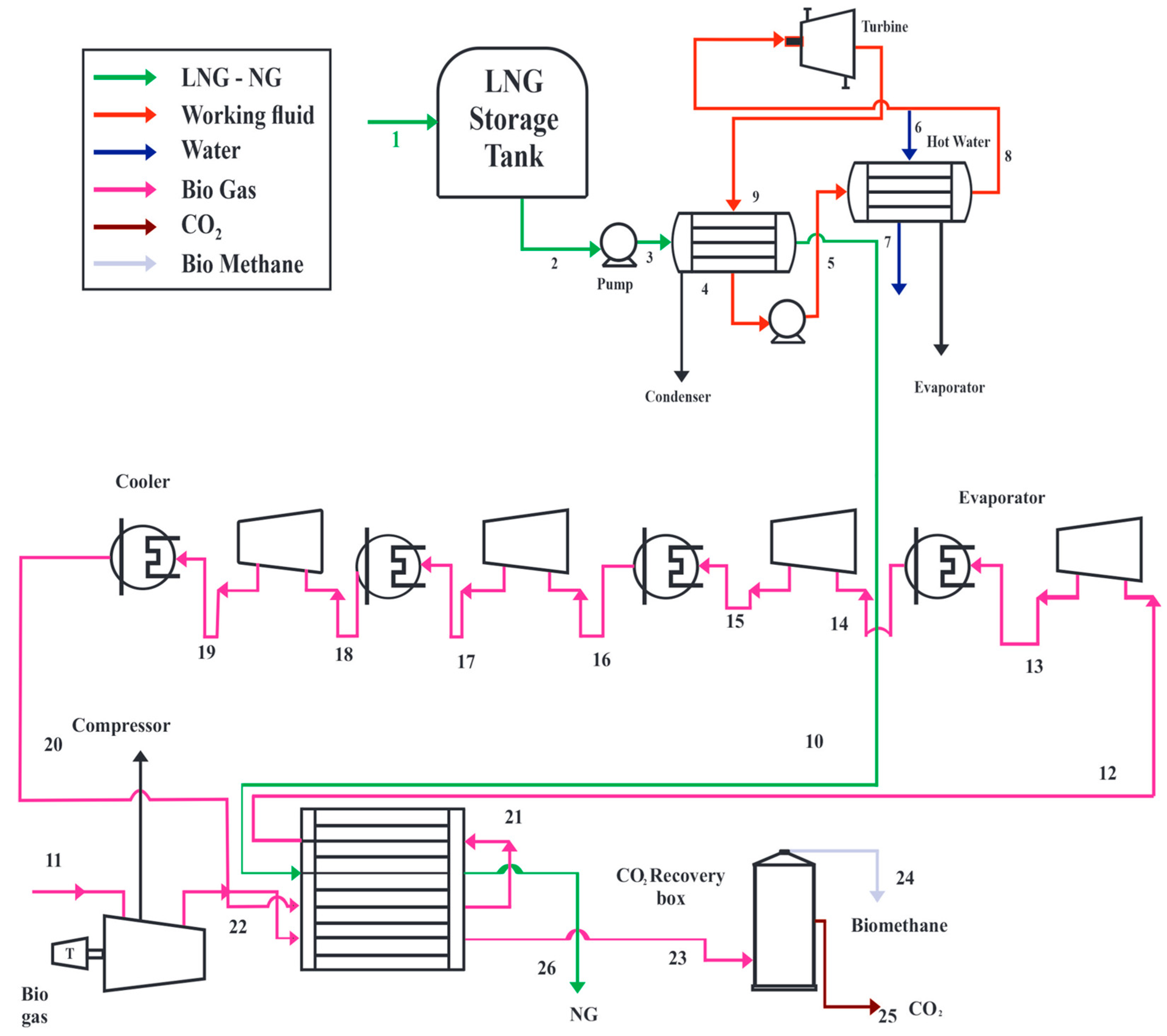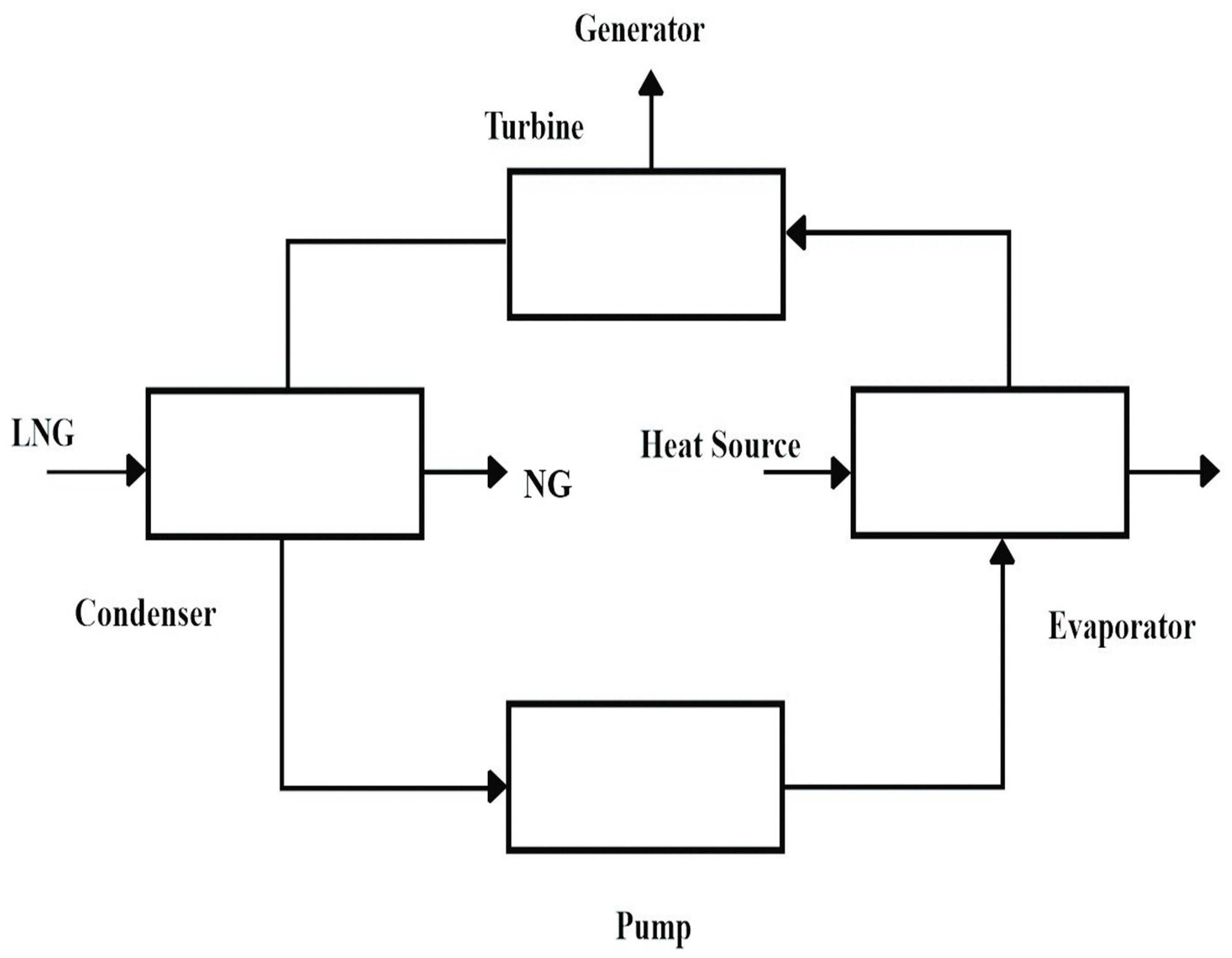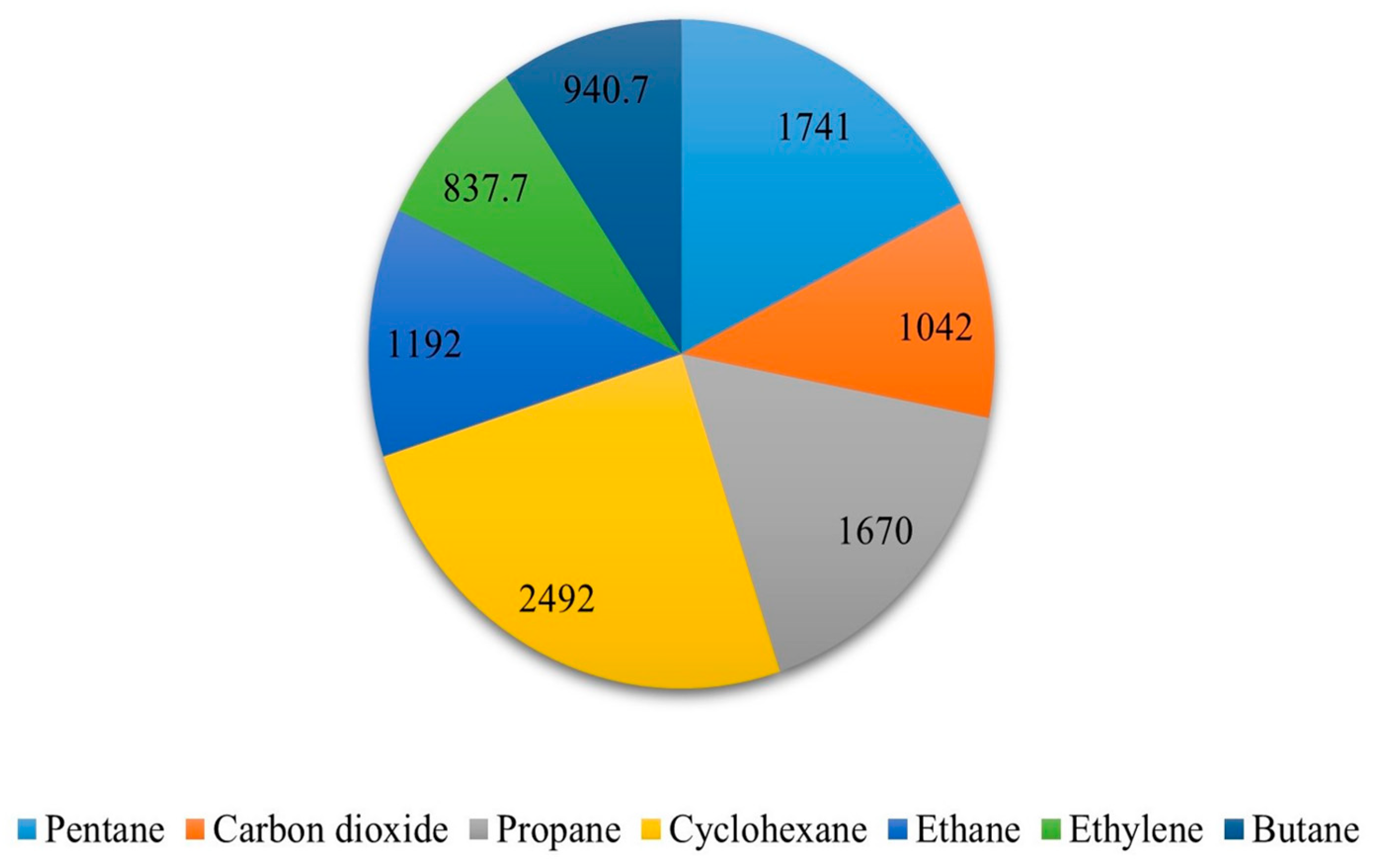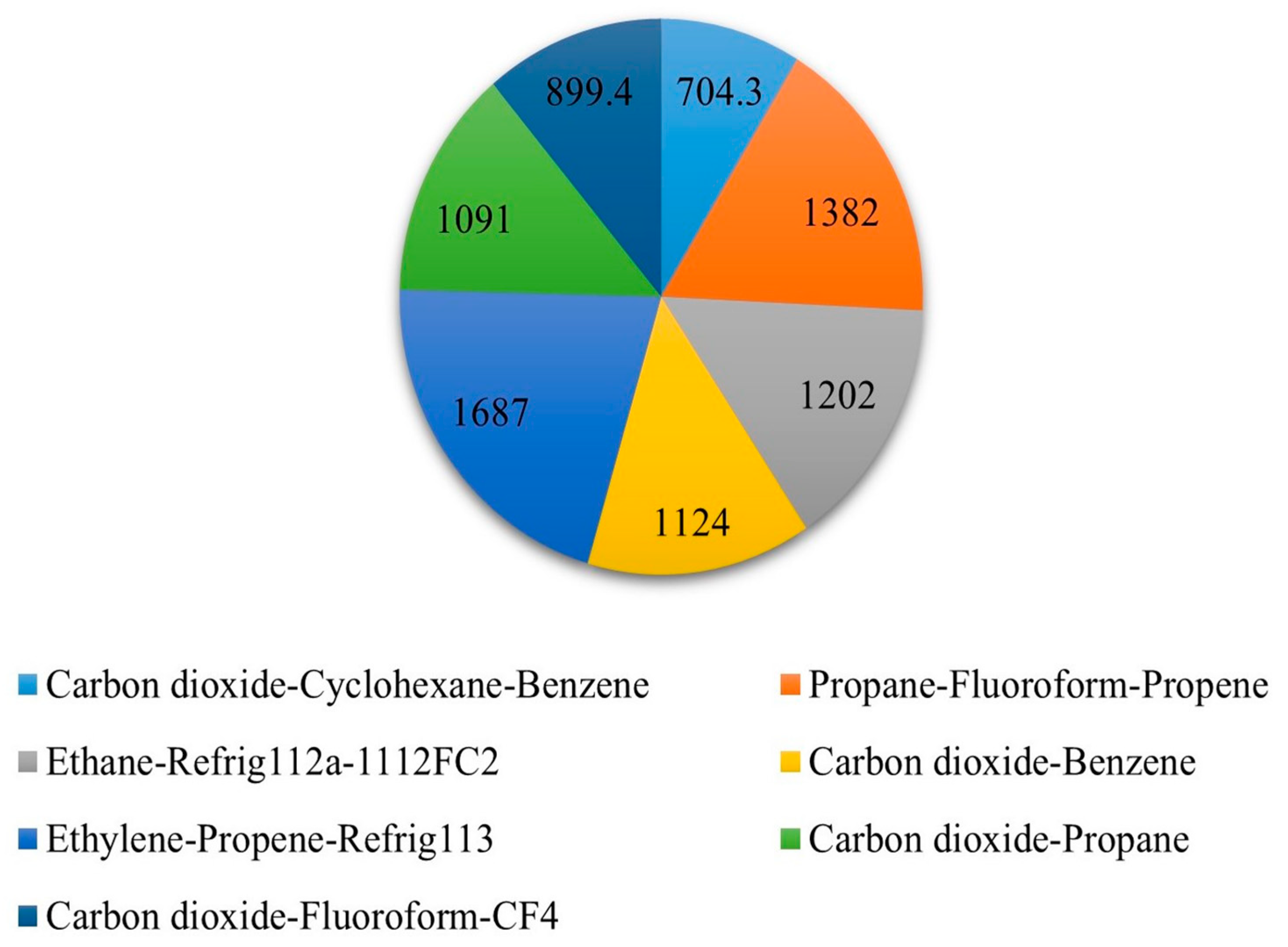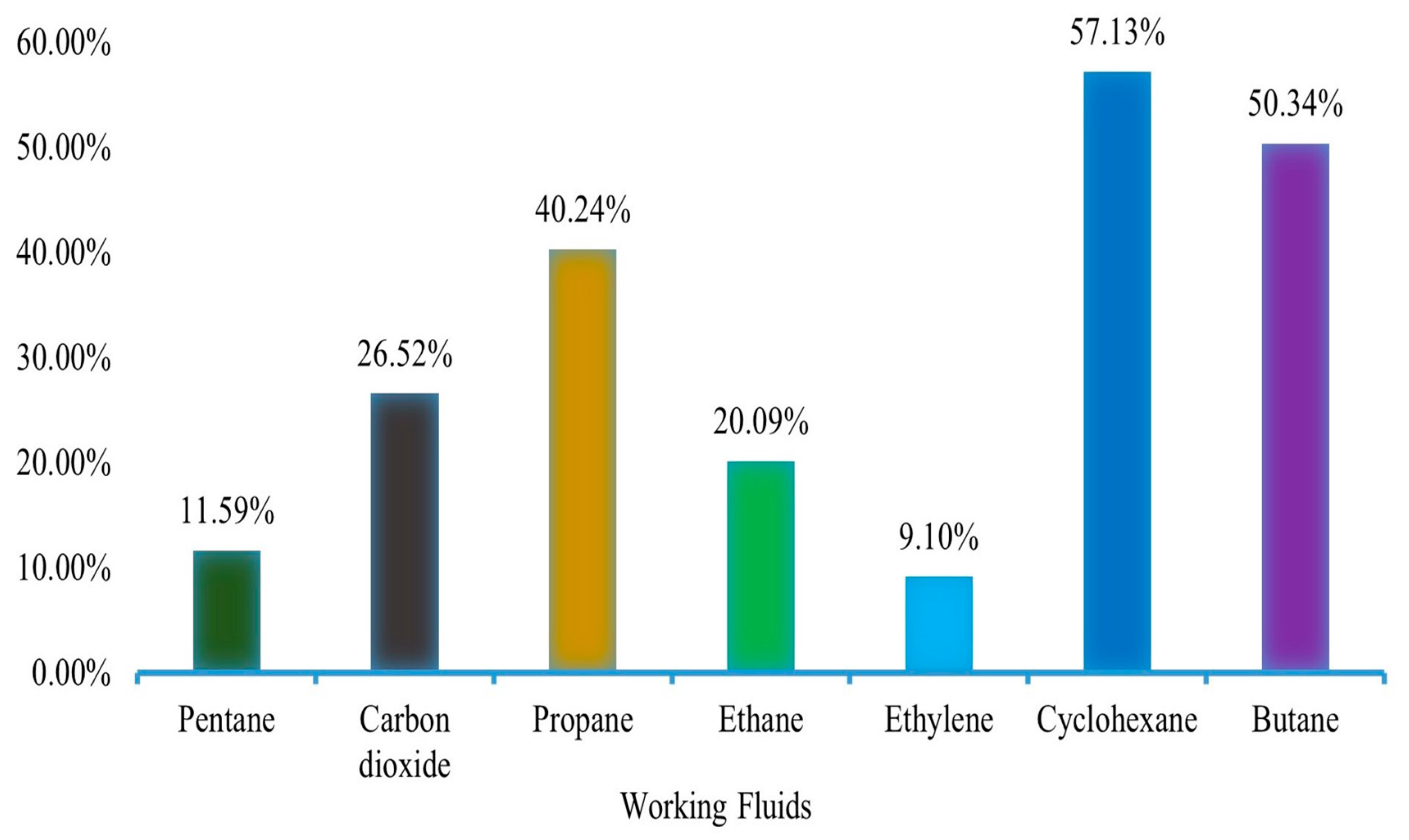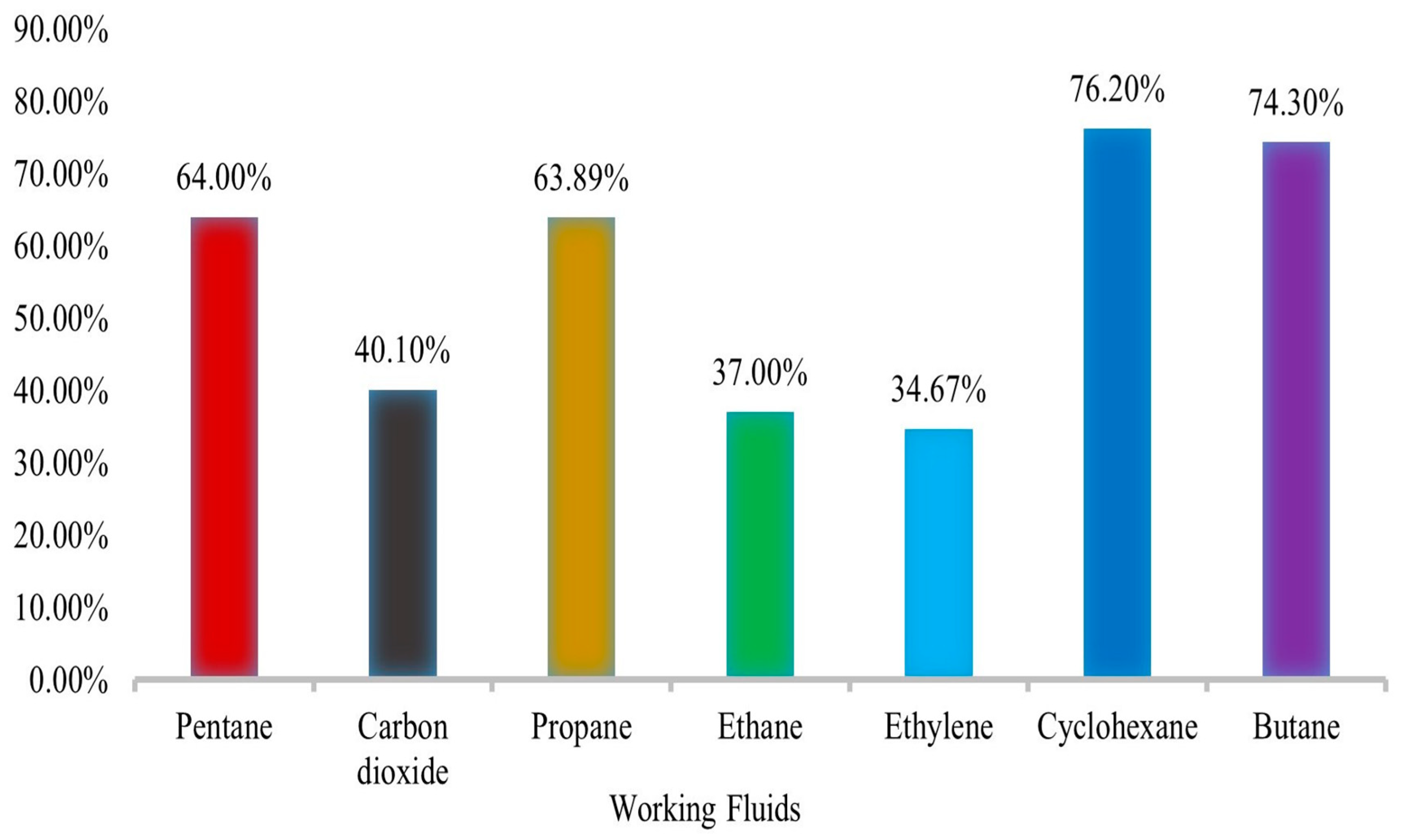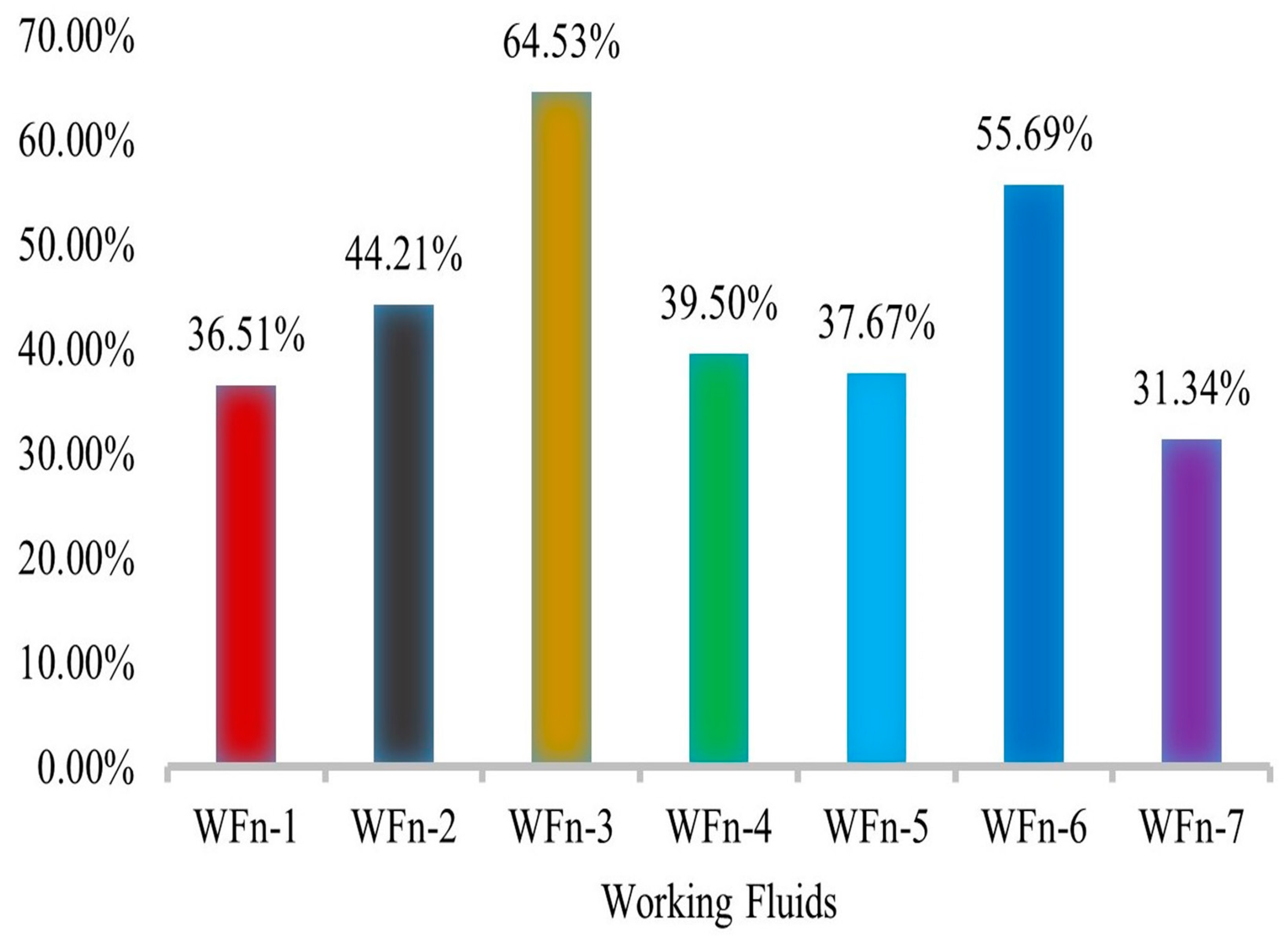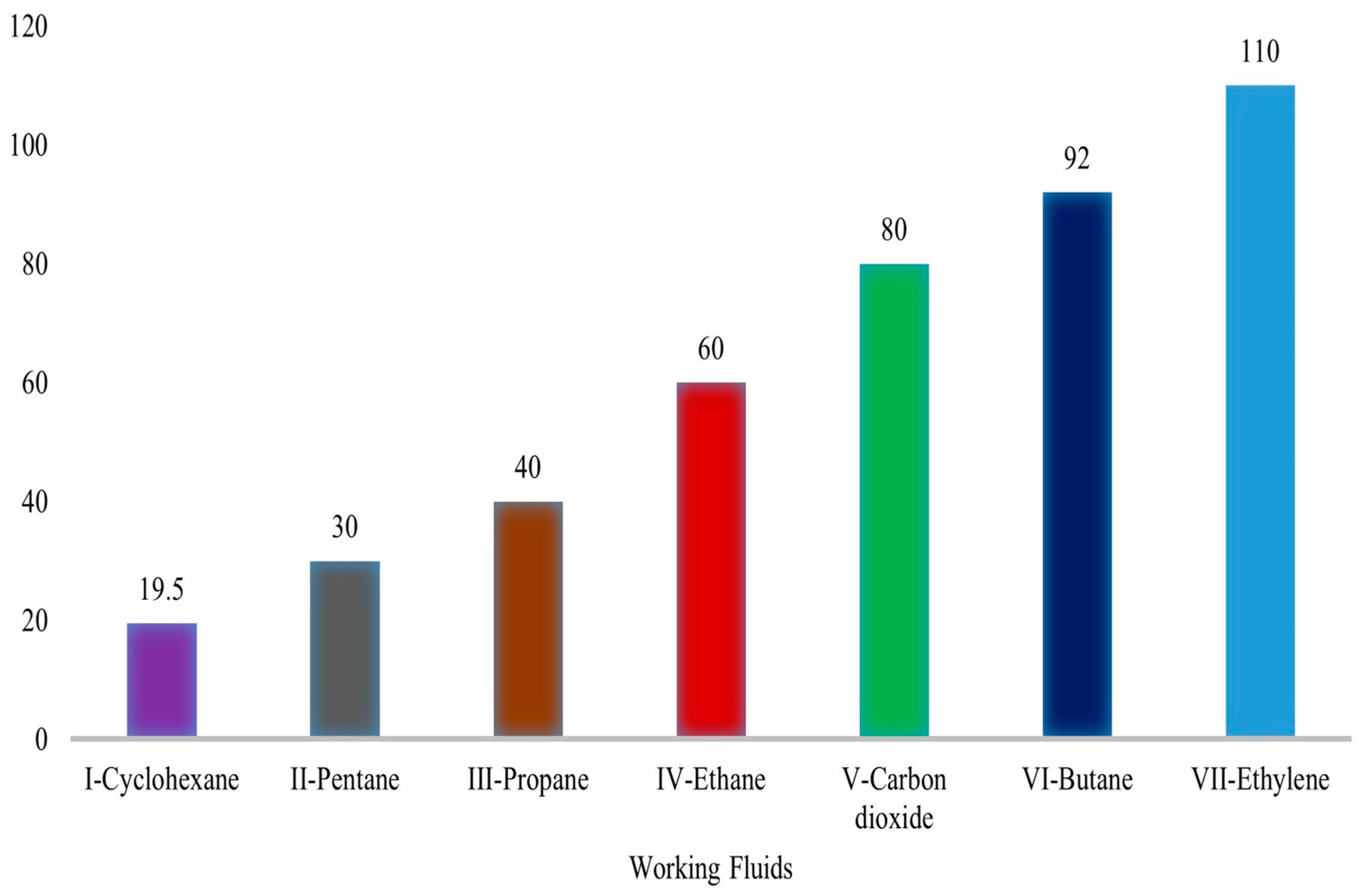1. Introduction
Energy sources play an important part in the smooth progress of an emerging industrial economy, which helps keep production costs low to compete in international markets. As a result, a good economy provides resources to improve healthcare, education, water supply, and sanitation for the citizens [
1]. Industrial growth, economic progress, and a good living environment are directly related to a cheap and clean energy supply. Therefore, sustainable clean energy sources are always in demand, and lots of work is being done in research [
2]. It is noted in the British Petroleum statistical energy review of world energy (2019) that world energy demand will increase from 580.5 TJ in 2019 to 775 TJ in 2060 [
3]. Economic growth and population increase are the major causes of this rise in global energy demand [
4]. In energy production networks, the energy gap between supply and demand is large because of off-peak and on-peak times [
5]. Therefore, there is a need to develop efficient clean energy generation technologies to meet global energy demands.
Fossil fuels (coal, oil, and natural gas) have been the primary energy source until now. These fuels generate greenhouse gases, which consist of carbon dioxide, carbon monoxide, nitrogen oxide, and sulfur oxide [
6]. These emissions increased by up to 1.2% annually between 2009 and 2018 [
7]. According to the 20-20-20 directive, the European Union (EU) has decided to decrease CO
2 emissions up to 20% by 2020, as per1990 emissions [
8]. The International Maritime Organization (IMO) has also initiated a greenhouse gas strategy to decrease these contaminants up to 50% by 2050 [
9]. Therefore, it is high time to develop such technologies that can restrict CO
2 emissions.
The transformation of low grade heat energy into electric power is the major property of Organic Rankine cycle (ORC) [
10]. The investigation of this power cycle efficiencies and the turbine has paramount importance for identification of their electricity production performance. It is also crucial to select environmentally affable organic working fluids those have compatibility with ORC facility [
11]. Japan was the first country to utilize and recover LNG cold energy with ORC at Senboku terminal in 1979. There were used Propane (C
3H
8) as working fluid and hot sea water as thermal resource in evaporator. There was total electric energy generation was 1.45 MW [
12]. ORC has emerged as suitable option to exploit LNG cold energy to produce electricity [
13]. The LNG cold energy has capability to improve the power cycle efficiency and minimize greenhouse gases emissions [
14]. Computational studies show that the Genetic algorithm (GA) has ability to increase the electricity production from ORC [
15].
The world economy is considerably dependent on fossil fuels at present. These energy sources produce huge quantities of environmental contaminants. Considering these serious environmental challenges, it has become necessary to utilize clean energy fuels to control contaminant emissions [
16]. Natural gas (NG) is a clean fuel because of its chemical composition, and it is quickly becoming a primary power source with the benefit of clean and effective combustion and multiple usages in vehicles, energy generation plants, industrial purposes, and as a kitchen gas [
17]. The worldwide NG demand increased up to 3.67 trillion cubic meters (TCM) in 2017. Their consumption is expected to grow around 4.9 TCM till 2040 [
18]. Liquefied natural gas (LNG) has cold energy around (830 to 860 kJ/kg) [
19]. Therefore, efforts must be made to develop technologies for utilizing LNG’s cold energy potential. This cold energy has the potential to run the cryogenic processes. Furthermore, this source can produce clean energy and curtails environmental pollutants such as CO
2.
A substantial quantity of energy is consumed in LNG production from NG. Regasification is the process by which LNG is changed back into its gaseous phase [
20]. The LNG regasification has strong potential for energy regeneration [
21]. The majority of LNG regasification terminals are functioning without any energy regeneration technique. This recovered energy can be used to increase power generation efficiency [
22] and to run cryogenic processes [
23]. The world’s scientists are well aware of this beneficial proposal. They are working to develop different integrated energy systems integrated with LNG regasification facilities.
Cryogenic CO
2 capture has not been extensively investigated like amine absorption or oxy-combustion. It is because of the reason that it is analyzed as an energy-intensive technique, although it produces liquid CO
2 [
24]. The prominent cryogenic technologies that can be employed to capture CO
2 are cryogenic distillation, external cooling loop cryogenic carbon capture (CCCECL), anti-sublimation (ANSU) CO
2 capture, the CryoCell cryogenic process, and the Stirling cooler system (SCS) [
25]. These options are not considered as energy-efficient or cost-effective processes.
Moreover, the carbon capture and storage (CCS) technique is quite promising and one of the quickest solutions to confront environmental change [
26]. Many programs are underway globally for developing an effective and minimal energy consumption CCS technique [
27]. The specific techniques that are employed for capturing CO
2 are solvent absorption, membrane separation, adsorption, and low temperature separation [
28]. The main cryogenic or low-temperature separation methods are liquefaction and ANSU separation. These methods can be employed by recycling dissipated cold energy. According to the CO
2 phase diagram, it is evident that liquefaction needs high pressure, up to 15,000 kPa. In the ANSU technique, CO
2 is converted directly from a gaseous state at a pressure lower than its triple point (for ANSU pressure at −78 °C, this is 100 kPa). Because of such impactful benefits, including lower pressure systems for plant safety and relatively minimal energy consumption, cryogenic ANSU CO
2 capture has an edge over other techniques [
29].
Cryogenics is a new approach in comparison to different biogas purification technologies. It comprises the purification of gases relative to their condensation or sublimation temperatures. The selection of CO
2 separating techniques among ANSU or distillation depends on the desired phase (solid or liquid) [
30]. Cryogenic distillation needs high pressure and cryogenic temperatures [
31]. It consumes a high amount of energy in the steps of compression and chilling. It also needs a multi-stage compression system, which negatively affects cost optimization [
32]. The main components of biogas are methane (CH
4) and CO
2. To acquire a good purity of CH
4 as a substitute for NG, CO
2 and other impurities (N
2, H
2S, and O
2) are required to be separated from biogas [
33]. In the ANSU CO
2 capture process [
34], CO
2 is separated from biogas via solidification at the heat exchanger surface (a categorically fabricated cold box) and removed subsequently through the surface in a liquid or vapor state with better product quality [
34]. Biomethane can be liquified (also called LBM) at a substantially lower price through the ANSU process in comparison to the cryogenic distillation process [
32].
In this research study, a novel integrated energy system of LNG regasification—ORC— and an anti-sublimation process uniting a biogas system is proposed. This system produces electrical energy from LNG integration at ORC. The ANSU CO2 low-temperature capture is highly energy consuming and costly process. According to studies, it is now established that using LNG cold energy for the ANSU process appreciably improves the thermodynamic and technoeconomic feasibility of the process, i.e.,; (energy and exergy efficiencies). The environmental regulation bodies, government authorities, energy development boards, industrialists, and other related fields may benefit from this poly-generation (tertiary) system. In the coming years, focusing on economic optimization of the process (product cost) is the key to materializing this proposed energy system on a commercial basis.
This paper is compiled in such a manner that initially the benefits and importance of clean energy recovery and the sustainability of cold energy recovery techniques are discussed in (
Section 1 and
Section 2).
Section 3 delineates the methodology to optimize this system. It also devised a model to utilize clean energy sources such as ORC. In
Section 4, the obtained results of thermodynamic and techno-economic assessments are elaborated. And finally, conclusions along with future directions are delineated in
Section 5.
2. Literature Review
Regasification terminals are now the center of attention for exploiting the potential of LNG’s cold energy. In regasification the of LNG, the temperature gradient is from −161 °C to ambient temperature. This cold energy has an estimated worldwide potential of producing 100 billion kWh and its market value is around 10 billion USD and increasing. Japan is taking measures to exploit this cold energy potential by producing electric power [
12]. LNG cold energy can be efficaciously utilized in an ORC condenser, which is a clean geothermal source [
35]. In this power production cycle, careful manipulation of organic working fluids/refrigerants is required to generate power [
36]. Studies have shown that ORC is an efficient power generation technology. It is due to the fact that the maximum energy efficiency of an ORC configuration is around 67%. While, the Stirling, Brayton, and Kalina power cycles energy efficiencies are 37.2%, 51.2%, and 13.45%, respectively [
37]. GA has the key potential for optimizing the ORC for better results [
38]. Hereafter, clean electricity can be obtained using this geothermal source [
39]. In addition, LNG cold energy can run industrial cryogenic processes [
40], similar to ANSU.
For many decades, various investigations have been performed to discuss the CCS techniques from the perspective of elaborating their process parameters. As a result, environmental problems are on the rise due to growing energy demands and the burning of fossil fuels [
41]. In this context, Yurata et al. purified the hydrogen (H
2) by separating CO
2 using the ANSU process in 2019. The total energy consumption for the removal of one kg CO
2 was 8.19–11 (MJ/kg) [
42]. In 2020, Gatti et al. mentioned the technical and economic capability of CO
2 capture processes. The result shows that the ANSU process can separate CO
2 from flue gas of natural gas fired plant, and its total equipment cost is 159 million [
43]. In 2021, Cann et al. conducted an experimental study using the CO
2 anti-sublimation mechanism in CCS. There was a comparison made between ceramic and steel bed materials to enhance CO
2 removal [
44]. In 2022, Ababneh et al. investigation also purified flue gas, limiting 0.3% CO
2 in clean gas, using a combination of anti-sublimation and a solid–vapor separation unit [
45]. In 2022, Naquash et al. worked on CO
2 removal from liquefied hydrogen using ANSU. This system has a total acquisition cost, energy consumption, and exergy efficiency of up to 52.8 million
$/y, 9.62 kWh/kg, and 31.5%, respectively [
46].
In the present energy scenario of the world, it is high time to propose an effective and economically viable multi-dimensional energy system that purifies raw gases and provides a clean energy recovery system. Considering the abovementioned literature, some significant configurations are proposed to make clean electrical energy.
Contributions of This Paper
This simulation research work is making these contributions to the current scientific literature:
The present research work shows unique thermodynamic and economic comparisons among 14 configurations of LNG regasification and electricity production with a capacity of around 200 million tons per year. This study’s goal is to increase system efficiency and CO2 separation through the utilization of LNG cryogenic cold energy. The analyzed solutions could assist the national electric grid as an additional power source, meet power requirements in carrier ships at ports, provide electricity to port industries areas, provide electric power to railways, supply power to naval strategic bases at ports, and provide electric supply to medical and education centers of developing areas in the vicinity. It also supports the policy of minimal environmental impact, supports cold-ironing, and the decrease of the environmental impact of maritime transports. This low-cost ANSU purification system can be useful for the world’s largest biogas plant in Vaasa, central Finland.
In the current scientific literature, modes of power output and its economic analysis are discussed. The present work demonstrated both first and second law efficiency and techno-economic values.
The avent-grade regasification system parameters are described, and a smart differentiation is presented on the basis of working fluid selection for proposed energy system configurations.
5. Conclusions and Future Directions
It is proven from this investigation that this novel integrated energy system has energy efficiency up to 57.13 %. It is due to the careful manipulation of organic working fluids in the ORC turbine. It is confirmed that the ORC energy system is identical to a steam engine. Now, it has materialized as a real clean energy generation system with technological advancement. Its major features are good flexibility and conversion efficiency at cryogenic conditions. There is a need to enhance its economic viability through the latest integration techniques, various manufacturing processes and materials, more novel development in optimization techniques, and low-cost, environmentally affable working fluids in the near future.
It is verified that the manipulation of a single working fluid of the ORC can generate a large amount of power, up to 2492 MW, in comparison to working fluids of multiple modes. It is because of this reason that its thermodynamic characteristics i.e., (i)—Critical temperature, (ii)—Boiling temperature, (iii)—Specific heat, (iv)—Latent heat of evaporation, (v)—Heat transfer coefficient, (vi)—Enthalpy drop, (vii)—Thermal stability, (viii)—Viscosity, (ix)—Specific volume, do not coincide with each other. It is also evident from the obtained results that the 2nd law of thermodynamics efficiency is higher than the 1st law of thermodynamic efficiency for identical energy systems.
This research work discloses a business case that is not shown in previous scientific studies showing consumption of LNG cold energy to generate clean electric energy and running ANSU CO2 capture process. It devises LNG regasification capacity 200 million tons annually at a seaport vicinity. It positively portrays to generate clean electric energy and minimizing an environmental contaminant (CO2) from novel integrated bio-gas setup via LNG cold energy.
The heat transfer devices that are linked to the presented novel integrated energy system are classified as condenser/regenerator, evaporator, and preheater. It is now evident that shell and tube heat exchangers show better results. For practical implications, there is also a recommendation to deploy shell and tube heat exchanger as condenser and evaporator in a practical ORC facility. It is due to its features of optimum heat transfer, minimum LNG freezing risk, on-shore/off-shore operation modes, and maintenance. This investigation makes a call to consume seaport area hot water in the ORC evaporator with the effects of its facile handling and no cost in summer.
The biogas has a large CO2 content of around 35%, and there is a large energy requirement for its cryogenic capture. It can be resolved by this proposed novel integrated clean energy system utilizing LNG cold energy. In this situation, environmental regulatory bodies, government authorities, industrialists, and academics can take advantage of the obtained thermodynamic and techno-economic assessments of this innovative integrated energy network.
